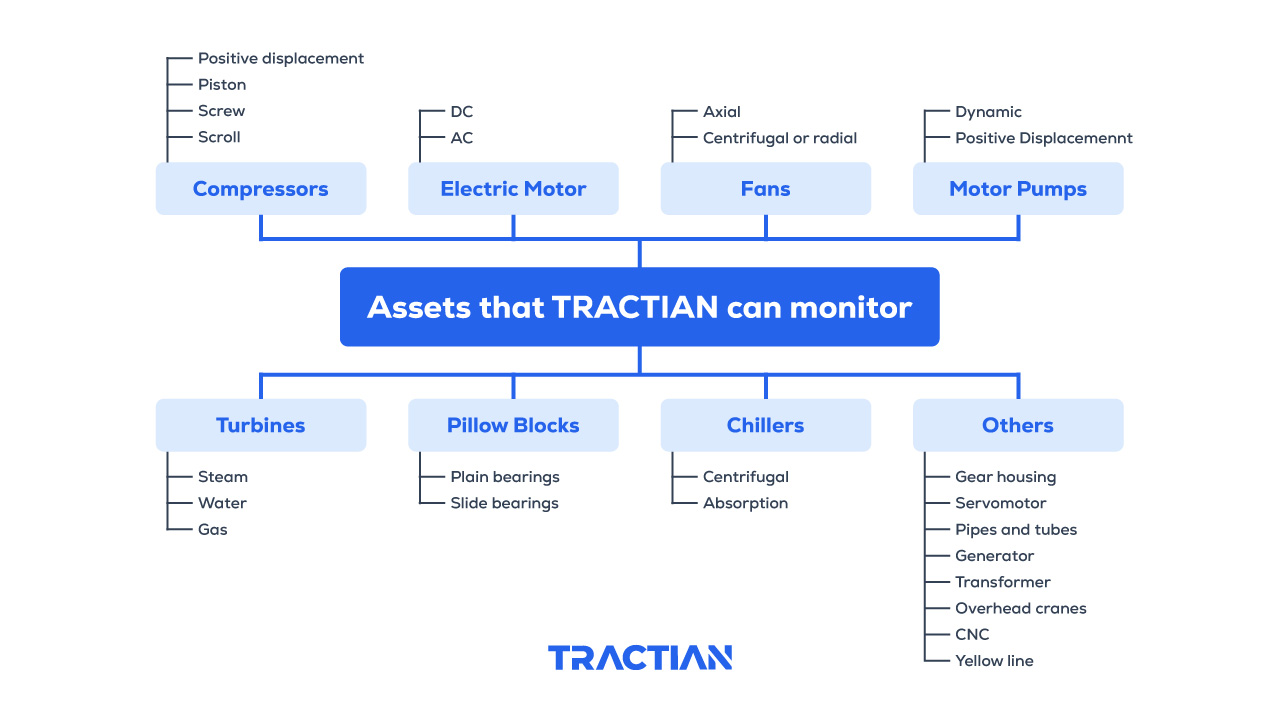TRACTIAN is revolutionizing the way industries and facilities manage their maintenance.
Our goal is simple: to empower the frontline workers of industries – the backbone of our economy – with the ideal combination of hardware and software they need to become the best in the business. It’s artificial intelligence used at the disposal of maintenance.
Our solutions were designed specifically for each stage of maintenance, and when combined, they allow full control and predictability over machines remotely and in real time.
We provide valuable information about machine performance, operating conditions, and maintenance needs with 3 main products:
- Online Condition Monitoring
- Maintenance Management Software
- Energy Management
Seeing all this in action may seem complicated, as our products are unlike anything else on the market. That’s why, in this article, we’ve gathered all the key questions and answers you need to know about TRACTIAN technology.
1. What are TRACTIAN’s main areas of expertise?
The main focus of our solutions is to reduce maintenance costs through products developed to solve real problems.
With the ONLINE CONDITION MONITORING sensor, TRACTIAN customers can monitor machine performance in real time, detecting faults and avoiding unexpected failures that can lead to unplanned downtime. This enables a predictive maintenance approach, rather than a reactive one, allowing preventive actions before serious problems happen.
TRACTIAN also offers ENERGY MANAGEMENT solutions, enabling clients to monitor and optimize their energy consumption. This results in cost savings, reduced waste, and a more sustainable approach to energy use.
Asset management can be simplified using a MAINTENANCE MANAGEMENT SOFTWARE (CMMS). That’s why we created TracOS™, a complete maintenance management solution that brings mobility, automation, and control into a single system. With advanced asset and work order management, besides SAP integration capabilities. TracOS™ makes it easier to optimize productivity, reduce costs, make data-driven decisions, and improve operational performance.
Learn more about condition based monitoring here

2. What is Smart Trac, the TRACTIAN vibration sensor, and how does it work?
Smart Trac is the IoT vibration and temperature sensor that uses Artificial Intelligence (AI) for automatic fault detection and prescription.
It collects temperature and vibration data in all three axes (x, y, and z) over time to set normal levels for each machine, and automatically sends that data to our online monitoring platform.
As soon as it detects anything out of the ordinary in the asset’s operation, the sensor alerts maintenance teams to take action while the failure is still in its early stages.
Smart Trac works in temperatures from -40° F to 230° F, and can detect failures such as unbalance, misalignment, cavitation, mechanical looseness, lubrication failures, and wear, among many others.
TRACTIAN’s fault detection technology is even patented by the USPTO, the world’s largest patenting institution, making Smart Trac the most advanced in the prescriptive maintenance market.
3. Do the sensors only monitor electric motors?
We’ll answer this question in two parts. Smart Trac, our vibration and temperature sensor, monitors over 100 fixed asset categories. These include electric motors, compressors, gearboxes, pumps, bearings, HVACs, generators, turbines, and so many others.

Essentially, Smart Trac monitors any and all rotating assets that work with some kind of critical behavior or that have a statistically defined vibration profile.
Energy Trac, on the other hand, collects three-phase voltage and current data from machines. It can monitor assets of any type of industry, as long as there’s power flowing.
4. Does Smart Trac only have an IP69K rating? Is it designed to monitor assets in classified areas?
The Smart Trac sensor has an IP69K protection rating against steam and high-pressure water jets, and is resistant to dust, high temperatures, and chemical environments.
For asset monitoring in classified areas, we created the Smart Trac Ex sensor. It’s Ex-rated for atmospheres with combustible gas or dust, and can continuously monitor harder-to-access machines.
It’s the ideal sensor for industries in the petrochemical, food, pharmaceutical, textile, brewing, pulp and paper, or power plant sectors, for example.
5. How are the sensors installed?
5.1 Is using a magnet the only way to install the Smart Trac?
No, the sensor base has a magnet that aids the installation process, but there are 3 types of fixing:
- Glue magnetic base on the asset using Loctite 330 adhesive (glue + activator);
- Screw the sensor directly onto the asset (M8x1.0x5.0 screw thread);
- Screw on the nut previously welded to the asset (M8x1.0 screw thread).
5.2 Is the Energy Trac sensor invasive?
The Energy Trac is installed in electrical panels and must be connected to the equipment’s voltage supply, which is mandatory to protect the circuit breaker. It’s compatible with DIN rails and has fixing magnets so that it can be positioned on metallic surfaces such as the electrical panel itself.
The sensor calculates electric current by means of current transformers (CTs). Because of the split claw design, you don’t have to open the circuit to install the sensor – it’s only necessary to identify if the orientation of the claws is adequate for the current flow.
In the case of electrical voltage, the sensor collects data via 4 wires connected in parallel to the power supply. The maximum voltage supported is 480V between phases or 277V between phase and neutral.

The current clamp must be used in the same phase as the voltage. The communication of the sensor is via an external antenna, which should be installed in a high location, preferably outside of metal switchboards.
6. Connectivity: Is my data secure?
Our products monitor vibration, temperature, current, power, and voltage of machines – it’s the only data collected and sent by the sensors.
This data is sent via mobile network (3G, 4G or LTE) to our cloud, which performs its processing and analysis. Using a mobile network instead of an industrial WiFi is important – it ensures greater data protection, since systems that go through a WiFi network end up exposing the company.
All data is sent in encrypted form, using AES encryption standards, which allows only TRACTIAN sensors and our servers to interpret the transmitted data.
100% of the data is stored in the cloud on the AWS (Amazon Web Service) system, which is completely compliant with all industry standards for data protection.
Smart Receiver Pro can communicate with up to 100 sensors in multi-channel in parallel. It can be positioned up to 100 meters away from the sensor in an environment with obstacles. In an open field, the distance can easily reach 1 kilometer.
Regarding infrastructure, the only thing needed is an electrical source (110/220V socket) for the receiver.
7. What’s the wireless protocol used in the communication between sensors and receivers?
The communication protocol used between sensor and receiver is a proprietary one, approved by the FCC, which is based on the IEE802.11, in 2.4GHz. Because it’s a proprietary protocol and communication based on MAC addressing, it’s impossible to have any kind of interference with any other local network.
8. How does data collection by TRACTIAN sensors work?
Smart Trac uses an internal accelerometer to measure machine vibration levels.
The vibration signal is transmitted to a controller inside the sensor, which processes the data and transmits it via a wireless connection to TRACTIAN’s cloud-based analysis platform.
The acquisition frequency collected by Smart Trac is 32 kHz, while that of Energy Trac is 8 kHz. The interval between collections can be set according to the user’s preferences, but we use the default of 4 minutes for Smart Trac, and for Energy Trac, 3 seconds.
9. How does automatic failure detection work?
Sensors attached to the machines identify vibration, temperature, current, voltage and consumption data and send it for processing, which is carried out by TRACTIAN’s monitoring platform.
This processing includes a machine learning model trained to examine the data and identify patterns associated with a specific failure.
TRACTIAN’s artificial intelligence compares the analyzed asset with millions of similar assets around the world, allowing for a detailed analysis of performance variations over time.
It is also with AI that we are able to perform failure Self-Diagnosis, which is the ability to automatically detect failures accompanied by a resolving diagnosis for the situation. It’s like a doctor for your machines, continuously monitoring their vital signs and alerting you to any potential problems.
This means that we can analyze and understand the performance of an asset in different operating conditions and automatically predict failures based on both the history of that machine and similar assets.
Learn more about TRACTIAN AI in this blogpost
10. Does the sensor eliminate vibration analysts?
Our sensor does not replace the field analyst! It serves as a co-pilot for your maintenance, and allows the team not to be dependent on or limited by the analyst.
One of the sensor’s biggest highlight is its Assisted Maintenance technology which, in addition to prescribing actions, offers precise diagnoses based on data collected online using prescriptive comparison.
If analysts don’t exist, the sensor can be used to meet the team’s needs. Otherwise, it becomes a complementary tool for work and quality improvement.
11. What’s the purpose of TracOS™ maintenance management software (CMMS)? Is there a data storage limit?
TracOS™ is an advanced maintenance management solution that combines mobility, automation and control in a single system.
The system facilitates effective asset management by offering features such as the asset hierarchy. In this function, you can create tree structures to organize your assets, add labels, attach documents and maintenance records at different hierarchical levels. In addition, the use of QR Codes allows quick, real-time access to the most important information. TracOS™ also proposes intelligent maintenance plans, which can be based on the calendar or the current state of the assets, helping to extend the life of the equipment and reduce failures.
With TracOS™, you can monitor both predictive and preventive maintenance in detail, setting up strategies based on the time and condition of the equipment. You can also accurately track MTBF, MTTR, backlog, availability, reliability, maintenance costs, financial planning and other data. Besides that, you can unify your data with full integration to Power BI, without having to rely on lots of spreadsheets.
You can also easily plan and schedule Work Orders in the Activities field. Through the calendar view, you can have complete visibility of the availability of all performers and teams, making it easier to plan and schedule the Activity. Additionally, you can check all the crucial procedures and items needed for each activity are centralized in one place, simplifying access to and coordination of all the essential steps in the process on a single platform.
You can also manage access according to the profiles of each member of your team, setting up routines and data with access restrictions, to ensure the assertiveness of the information for each of the profiles. You can also receive and control notifications from the team profiles you manage.
TracOS™ has no data storage limit. It offers unlimited space for machine and maintenance information and history.
12. How can TracOS™ integrate with other ERPs and software on the market, such as SAP?
The integration between TracOS™ and SAP is done through an open API and a unique connector developed by TRACTIAN. Our team of experts maintains constant contact with your IT department to ensure a coordinated and transparent process from the beginning.
We take the time to understand the specifics of your routine to identify key requirements and work closely with you to integrate TracOS™ with your entire operation.
Using a rigorous methodology, we collaboratively develop a detailed blueprint of your process and how it’ll be structured in the system. This joint approach allows us to align the software perfectly with your operational needs, ensuring that every aspect is integrated and optimized.
If you would like to understand more about TRACTIAN solutions, contact us and schedule a demo.


